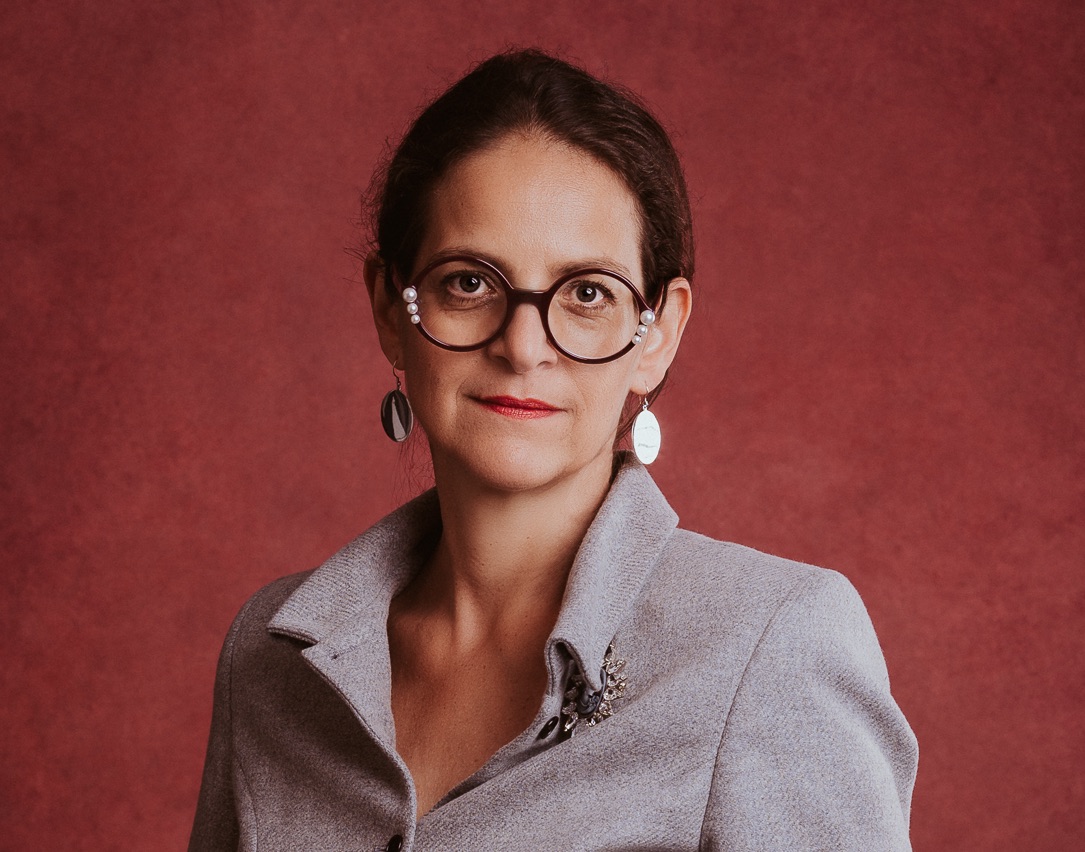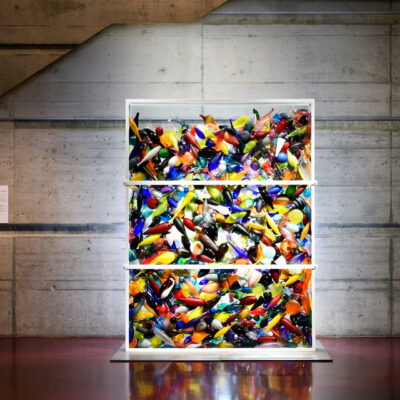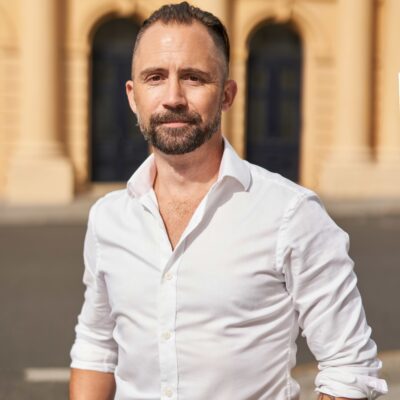Dr Gindi is a medical doctor turned sculptor based near Zurich, who is interested in the connection between the mental and the physical being, and who has a deeply philosophical approach to her work. Her sculptures convey a sweeping immediacy and unwavering authenticity that is hauntingly vegetating. Going against the tide of mainstream abstraction, she nurtures a veneration of the organic, in order to lead us back to the speculative edges of her creativity rooted in nature. Rejecting the Cartesian Self, her practice revolves around the inquiry of decay and the concept of infinity within the passage of time – the essence of the human condition. She has been dealing with these themes since entering the art world. We spoke with Dr Gindi about her latest works, her views on René Descartes’ scientific denial of nature, and the attainment of aesthetics.
Kristen Knupp, Art Vista Magazine: I see new acceptance in the medical practice as it embraces psychosomatics and more recently the concept of wellness, breaking from its traditional concentration on the physical. In your early medical practice, did breaking the old model permit you to see new methods and their application to the human condition? And what role did René Descartes play in influencing your creativity as a sculptor?
Dr Gindi: As a physician and following that, as a sculptor, I realized that the prevailing focus on the physical aspect of disease is utterly over-accentuated. Descartes himself considered the body as a flesh-and-blood machine that could exist through mechanical means alone, without much interaction from the mind. Within this mind-body dualism, he reaches the conclusion that body and mind can exist without the other. I would argue that today’s Western medicine is still under the spell of its history. But I began to break away – in my medical practice, and then soon through my sculpting which is rooted in nature, in contrast to Descartes’ doctrine of distinct perception which has put the intellect above everything else.

Dr Gindi, “Beaufort 7”, Bronze, 2020. 25 x 27 x 20 cm
KK: And how did your broad view of medicine inform your sculpting?
Dr Gindi: At one point in my medical career, I decided to shift to psychiatry as I saw health as a state of physical and mental well-being, and I would even include social well-being. A further transition, that from psychiatry to sculpture, was a logical one as art and integrative medicine – in my view – share the understanding that our emotions and social interactions affect our bodies and vice versa. Today, between fragility and strength, my sculptures – I hope – impart a sense of absconding, veiling, and at the same time yearning for transformation, probing the very essence of being in all its natural complexity. And I would like to overcome the mind-body dualism as it is set to find expression in imaginary definitions of incarnation – physical, mental and social. I am a non-Cartesian sculptor.
KK: Dr Gindi, most of your projects are realized in the classic way: modelling the sculpture in clay, making the mold, and casting the bronze through the lost wax process. Why do you work with clay? Do materiality and aesthetics form a whole in your work? And could you let us know how your interests in the relationship between sculpture and nature first began?
DG: I am an organic sculptor which means that I draw directly onto the clay and work from there – the piece almost always changes course as I proceed, it is like the piece had a life on its own. The clay – kneaded by my hands and fingers – begins to naturally emerge in front of me, notwithstanding the methodologies I learned – and unlearned – during my formal training where clay was mostly seen as a medium to legitimize the final guise, the bronze sculpture. We might even assume, as strange as it sounds, that the clay is living on after it is molded into bronze. Clay is indeed like an organism as it consists of minerals, water and organic material – nature is hailing its resuscitation in my sculptures. I use clay to demonstrate my connection with nature and – rather consciously – to prevail over the Cartesian dualism between object and subject, between body and mind, that has percolated the arts since René Descartes’ famous cogito ergo sum and its implicit refutation of aesthetics. Clay, unlike some other matter, is not an amorphous mass to be boxed into shape – it is rather an embodied circumstance and it carries a discursive creation of reality. I model in clay, cast in bronze and co-evolve with the enclayed sculpture, a process that underlines my quest for infinity. And my heightened acclaim of the infinity of nature.
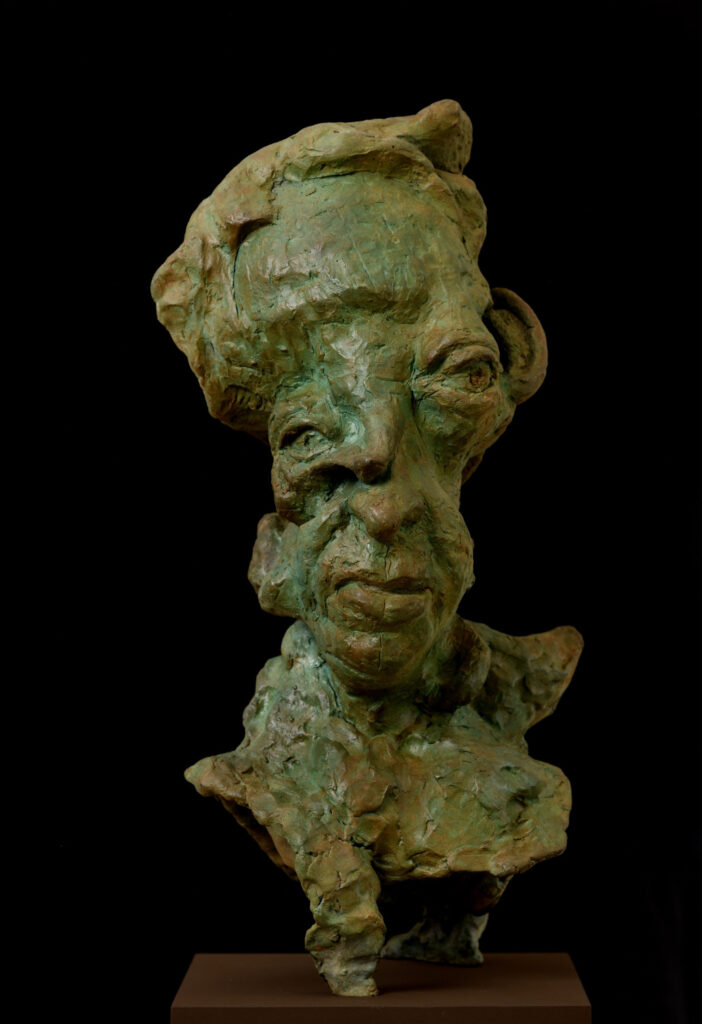
Dr Gindi, “The Horticulturalist”, Bronze 2021. 51 x 25 x 22 cm.
KK: I came across one of your latest sculptures ‘The Horticulturist’ that seems to encapsulate both the infinite potentialities we can reach in life, as well as a deep nexus with nature. I really love that piece in its cubistic fecundity. Tell us more about what inspired that work. And how you and your sculptures connect with the viewer.
I often open a dialogue on issues that have seemed private or too intimate to be discussed in the public space. To describe my artistic process very simply: I transform materials into objects that can, in turn, incite flux in their viewers. Take for example ‘The Horticulturist’: I illustrated an enlightened naturalist who has committed his whole life to the pureness of plants. He is germinating his infinite self. Prolific seeds of ardor he planted that should by now be grown. Indeciduous roses warm his field of bones. He becomes one with his objects of love – is he still a human or already transforming into a plant? His yearning for beauty made him an alluring but bizarre creature that can only be deciphered through the enticement in the viewer’s eyes.
I truly believe that we are able to live a symbiotic life in which the very constant is a fluidity of co-existence with nature. Coming back to Descartes: He considered anything to be true that is explicit and discernable. Nature, in his eyes, slumps into a set of rational and blasted equations. As the only logically-thinking and acting beings, Descartes rated us humans as being elevated to nature. I ardently disagree – we cannot subdue nature, as we are part of it. And I consider nature as something much bigger, as something ethereal – nature is the contexture to caress infinity. The Horticulturist is aware of that. He is not a depiction of nature. He and all of us are nature.
KK: Given the reality of climate change and nature loss, does your work associate with nature? Does nature inspire your sculptures?
DG: At the heart of my sculptural inquiry is the fate of the human being within its co-evolving surrounding called nature: a happenstance of our surroundings – not the natural reality of the birds and the bees. My inquiry entertains the possibility that the physical world is an illusion depending on the viewer and his experience of that world. Art, for me – to extend the metaphor – is not the imitation of nature, but a hypothetical complement enabling the afforestation of nature itself. If we gaze into the nature around us, nature does not always gaze back at us – climate change is a fact and we have to curb it. We are doomed to drift into moody momentousness as we are thrown into this fecund maze we know as our habitat; we are losing the sense of sustainability. Hence my sculptures seem mundane in a way, but also nerve-racking and sometimes they are rather unnatural, as if from another planetary ecosystem. I am sculpting at the tattered ends of nature. Does this make sense?

Dr Gindi, “The Horticulturalist”, Bronze 2021. 51 x 25 x 22 cm.
KK: Yes, indeed, but to question more deeply – how does nature inform your art? Is there art in nature? I ask this as you give the feeling of breaking with artistic convention as you aim to denaturalize nature within your own personal ecology.
DG: You are raising an important point. There is art in nature, everywhere. And I spend quite some time looking at flowering landscapes, the natural world, even urban bushland. As an evolving bonus, my sculptures are an invitation to develop a tentative introversion. They call one to venture through and within my crenations, whether you like it or not. Haunting the margins of the earth we might decide to traverse this jungle of exasperation, with all its exuberant flora and fauna. But I don’t want to mimeograph the weed-picking of some unhinged gardeners – I prefer the noble horticulturists. And certainly, I don’t want my own blossoming and withering experiences to become anyone else’s natural world. We are all of nature: as for me, I am who I am. And I sculpt.
KK: Coming back to your sculpting practice: You mentioned earlier on that you are an organic sculptor, in a rather non-Cartesian tradition. How does your leaning towards aesthetics translate into your artistic style, if there is anything classifiable like this? I personally feel that your work brings together the legacies of figurative art on the one hand, and those of abstract yet conceptual manifestations on the other, with your undivided interest in constructive narration and sudden utterance.
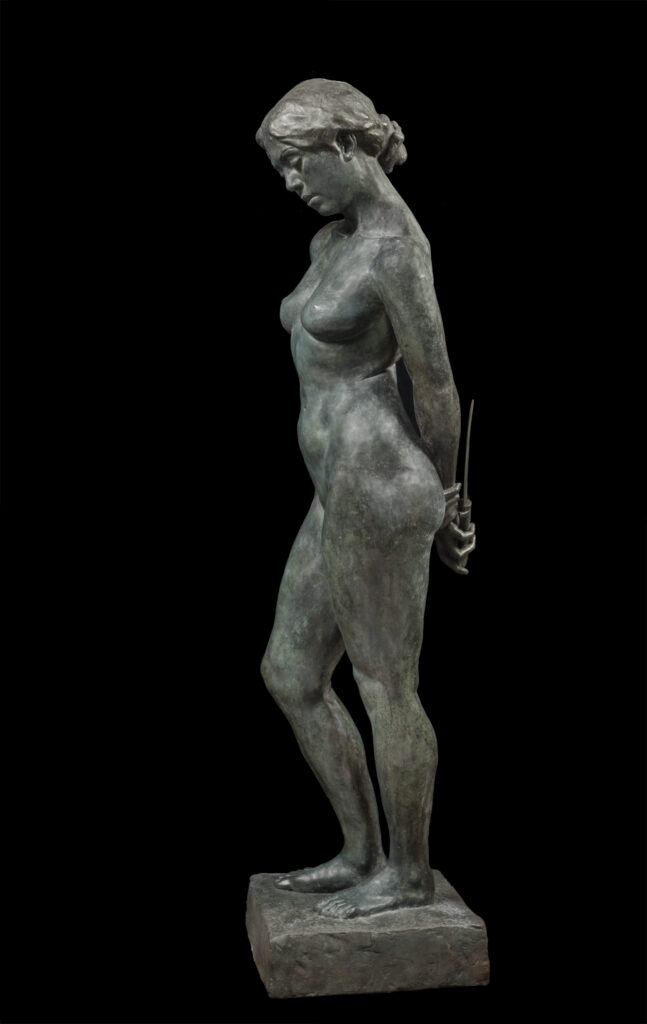
Dr Gindi, “The Fateful Choice”, Bronze 2021. 166 x 44 x 47 cm
DG: My current instinct is figurative sculpture. This stipulation might be a reaction to some flings of abstraction. I am certainty not dogmatic about my style as I make sculptures that resist codification. My work is – by intent or gross negligence – full of dichotomies as I seek to stage paradox and harmony, like a horticulturist zoomed into the eternal paradise. And my style, if there is such thing at all, is always developing and thus returning back to its origins – the figurative kneading of clay. You might say that I am beholden to the forms that I am modelling but I am not trapped by their Gestalt. I endeavor to depict life in all its vagueness, teetering between the factual realm and the subconscious. By doing so I reject Descartes overbearing anti-aesthetics, I still believe that an important purpose of art is to express emotion, and yes, beauty. The sensuous and imaginative experience brings lots of value to me. With my sculptures I am bowing to the past while providing a path into a future that shall give some breath of life to the abstract and to the sometimes soulless and nature-less excesses of modernity.
KK: You seem to follow your gut, follow your emotions, when approaching aesthetic sensibility in your work. And you obviously reject Descartes’ anti-aesthetics. Still, as an observer, I believe that you consider that beauty is a fickle thing. How do you define beauty? And how important is physical beauty for you?
DG: Sensuous and imaginative experience was of rather little value to Descartes, he only allowed for mathematical beauty. What a narrow view! Sure, beauty can be approached mathematically but it is much more than that, as it can be experienced with all our senses, it is all around us, and within us. I sometimes pause for a moment when walking through my imaginative journeys, I start to laugh or weep when discovering the beauty of a plant, a human being, a piece of art. I have to admit that I have an eye for beauty, for beautiful objects and subjects that find form in their undraped, natural being. The allure of nature lights up the brain. And I want to eternalize such beauty with my sculptures.
